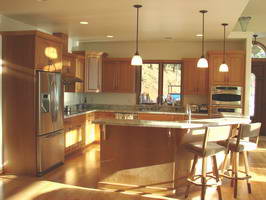220 Volt Appliance Wiring Requirements
 '; ';
|
Why do most 220 volt appliances not use a white common neutral wire? How to Wire a 220 Volt Appliance. © By: Dave Rongey |
Why Some 220 Volt Appliances Do Not Require a Neutral
Electrical Question: Why do most 220 volt appliances not use a white common wire?
- Why do they use two hots and a ground and not a neutral wire?
This electrical wiring question came from: Emmett, a Homeowner from Port Orange, Florida.
Dave’s Reply:
Thanks for your electrical wiring question Emmett.
Application: Installing a 220 Volt or 240 Volt Circuit.
Skill Level: Intermediate to Advanced, Best installed by a Licensed Electrical Contractor. Work in electrical panels is not recommended for homeowners, non-experienced individuals or non-electricians.
Tools Required: Basic Electricians Pouch Hand Tools, electric drill, auger bits and extension cord.
Estimated Time: Depends on personal level experience, ability to work with tools and install 220 volt electrical circuit wiring.
Precaution: Identify the main circuit of the panel, turn it OFF and Tag it with a Note before working with the wiring or installing the 220 volt wiring and circuit breaker. Working in an electric panel is dangerous due to arc flash hazards and the possibility of electric shock.
Notice: Installing an additional 220 volt circuit should be done according to local and national electrical codes with a permit and be inspected.
How to Wire a 220 Volt Appliance Circuit
Some 220 Volt Appliances Do Not Require a Neutral
- Most 220 volt appliances have heating elements that are designed to use 220 volts for fast heat production.
- A 220 or 240 volt circuit is more efficient than 120 volt because it uses equal amounts of power from the two main circuits of the electrical panel.
- Typical 220 volt equipment are ovens, stoves, water heaters and water heaters.
- The ground wire must be attached to the metal enclosure to protect the equipment in the case of an electrical failure.
- Newer ovens and clothes dryers do require a neutral wire because of electronic controls that require 110 volts to operate.
- With new controls being designed to make equipment more energy efficient I expect to see more circuits requiring a separate neutral wire or a 4-wire circuit.
More about 220 Volt Electrical Circuit Wiring
For more information about 220 Volt Wiring Diagram
220 Volt Wiring Diagram
Wiring 220 Volt Electrical Outlet
Home electrical wiring includes 110 volt outlets and 220 volt outlets and receptacles which are common place in every home. See how electrical outlets for the home are wired.
The following may also be helpful for you:
|
|
Be Careful and Be Safe - Never Work on Energized Circuits!
Consult your Local Building Department about Permits and Inspections for all Electric Wiring Projects.
More articles about 220 Volt Wiring, Electrical and Home Electrical Wiring: |
|
| « Previous | Next » |
Can I Use A Remote Control Switch For Lighting? |
Electrical Voltage Problems and Solutions |














